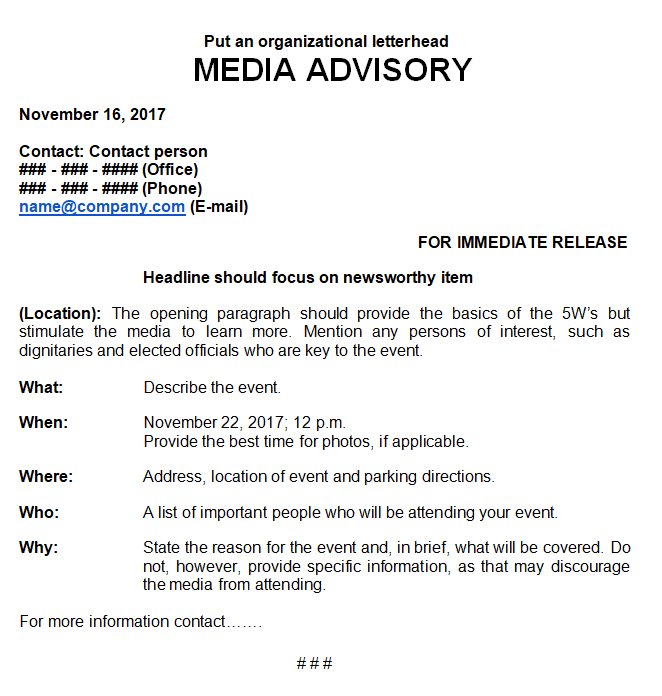Do you recall the first time you sent a media alert for your business? I do. I was overjoyed to announce our new product launch, knowing that the media would be as enthusiastic as I was. So, I carefully drafted the alert, sent it, and waited for the onslaught of coverage. But instead, I received crickets. Not one response. It was a sobering event, to say the least. That’s when I realized I’d made the most common mistake in media alerts: I hadn’t tailored my alert to the media’s requirements and interests. In this post, we’ll look at this common mistake and how to avoid it, ensuring that your next media alert not only gets opened but also receives the coverage your firm deserves.
Understanding Media Alert
Before we get into the mistake, let’s define what a media alert is.
Media alerts, also known as media advisory, are brief communications, or ‘alerts’, sent to media members informing them of a forthcoming event that they may be interested in. Unlike a media invite, which is typically used to welcome the media to an exclusive event such as a product launch, a media alert also strives to offer the media relevant information to share with their audience in addition to the invitation.
A media alert often includes the facts of the event, such as the date and site, anticipated events, and the attendance of significant persons, to draw the attention of the media and their readership.
Key Takeaways
- The biggest media alert mistake businesses make is failing to personalize their alerts to the media’s requirements and interests, which significantly impacts the likelihood of receiving media coverage.
- Media alerts are brief, direct communications sent before an event to attract media attention and encourage attendance, while press releases are detailed accounts circulated after an event to report on what occurred.
- Personalizing media alerts is crucial because it increases relevance to journalists, builds stronger professional relationships, and leads to higher open rates.
- Effective media alerts should be concise, use a clear format, include high-quality visuals, and be sent at the appropriate time to maximize engagement from journalists.

What is a Press Release?
A press release, on the other hand, is an announcement made to the media to recount what occurred at a certain event. A press release is frequently produced in considerably greater depth, including statements and other important information presented during the event. In addition to event stories, a press release might include other noteworthy information, such as product launches, market expansions, and significant honors and achievements, to obtain media attention.
An excellent example of a press release is Meals In Minutes’ announcement of their most recent investment round:
The Fundamental Differences Between Media Alerts and Press Releases
To assist you in understanding the distinctions between a media alert and a press release, we’ve divided them into separate categories.
#1. Goal
- Media Alert: Media alert is to attract media attention and increase event attendance. Media warnings are frequently made to garner media attention and are typically brief and focused.
- Press Release: Designed to gain media attention, but also serves as a full account of events after they occur. It is frequently published in news pieces, with a detailed explanation of the event and pertinent details.
#2. Length
- Media Alerts: Media alerts are concise and attention-grabbing, often around one page. It contains the most important data about the upcoming event, such as a description, key guests, date, time, and venue.
- Press Release: More factual and detailed, usually two to three pages long. It reports on the events that occurred, including data, remarks, statements, and promotional aspects, and is intended to be published verbatim.
#3. Content
- Media Alert: Media alert content is concise and direct, to convey information quickly. It contains vital information such as the event description, date, time, and venue.
- Press Release: A detailed report on the event, containing important messages, comments, commentary, newly announced information, and extra background on linked companies and speakers.
#4. The timing of circulation
- Media Alert: Shared before the event date to attract media attention and encourage attendance.
- Press Release: Circulated after the event to include appropriate quotes and additional information about the event.
How To Send Your Media Alert: Format and Style
To make media alerts easier to understand for journalists and producers, include crucial information in a table, such as “what, who, when, where, and why” (see sample above).
- Insert the table into a document exported as a PDF email attachment (in case the journalist has to print it and demonstrate branding credentials), as well as into the email body for easier reading and reference.
- Use a clear and easy-to-read typeface (san serif is preferred), color, and size.
When submitting your media alert, be sure to:
- Send it from a professional email address, not a personal or personal-looking one.
- “Bcc” the list of recipients, and enter your own email address in the “To” and “Cc” email fields.
- Take note of the “bounced” email responses indicating that the recipient has left the role, and promptly update your media contact list (this is a great habit to develop).
- Ensure your email signature is complete and up to date.
A full and up-to-date email signature is vital because it:
- Verifies the veracity of your media alert.
- If you provide your phone number, the journalist or producer will be able to contact you more easily.
- If you include a website address and social media channel widgets (icons that link to your channels), the writer or producer will be able to learn more about your organization.
Additional Tips For Writing Media Alerts
It’s good to remember the following when creating and distributing media alerts:
- Use a media alert for significant initiatives when you don’t have time to write a media release when images are required but will not be accessible until after the event/initiative, or when you want to schedule a radio interview before the event/initiative.
- If your media alert surpasses one page in Word, it is too long.
- Avoid using jargon, including Church jargon, in your alert so that the journalist/producer can use intelligible words in their news reports (for example, substitute “fellowship time” with “an informal gathering”).
- Only send out media alerts (and media releases) for initiatives with considerable relevance (i.e. newsworthiness) beyond your faith group (if you send too many media alerts and releases that are not newsworthy, a journalist may stop opening future emails from you).
- Send your media release one to two days before the event/initiative, ideally in the early morning.
- Choose proper phrasing – use inclusive language (it conveys respect) and avoid words that may sound strange or perplexing to an unchurched audience (for example, “Passion Play”).
- While your media contact list may include dozens or hundreds of email addresses, follow up with a phone call to a few key publications, such as those in your area or those who are particularly interested in the subject of your alert.
- Ask someone with a keen eye to proofread the media alert and double-check the important details, particularly the date/time and place.
- Use a media alert template (e.g., Microsoft Word or another document that you may convert to PDF) that includes a logo, social media account information, and a footer with contact information. For further information on how to obtain a sample template, please see below.
- Post your media alert on your social media accounts, tagging a few particularly relevant newspapers and using a few relevant hashtags (for example, in the case of the live reading vigil, “#NauruFiles” and “#auspol”).
Structure of a Media Alert
In summary, compose your media alert email in the following order:
- Email subject line.
- Headline.
- Brief and simple professional greeting.
- Very brief intro paragraph (two sentences maximum).
- Copied and pasted table of “what, who, when, where, and why” essential details.
- Email signature.
- Attach the branded PDF of your media alert.
- “Bcc” the list of recipients, insert your own email address in the “To” and “Cc” email fields, and then hit “Send”.
Using a Media Alert Template
A Media Alert Template might help to ease the customizing process. This template might help you arrange your information and make sure you don’t overlook any important facts. Here’s a simple structure to follow:
- Headline: A brief, eye-catching title.
- A brief summary of the announcement.
- Event Details: Who, what, when, where, and why.
- Contact Information: Who you should contact for more information.
By tailoring each component to the journalist’s interests, you may develop a more interesting and relevant media alert. Download the template below;
Best Procedures For Media Alerts
Keeping this information in mind, here are some recommended practices you can apply when creating media alerts in the future:
- To write an effective media alert, keep it succinct and to the point. Ensure that journalists do not spend more time than necessary to gather critical information from the alert.
- You can write in an inverted pyramid approach to guarantee that the correct information is supplied, with the most important information delivered first. This is followed by any necessary clarification and additional details about the approaching event.
- Because media warnings are more basic, employ persuasive but direct language to convey the message. Avoid jargon and flowery language when writing media alerts to keep journalists’ attention.
- Include your contact information at one of the top corners or at the end of the media alert so that the journalist can readily reach you if they require any additional information.
The Biggest Media Alert Mistake: Lack of Personalization
The most common mistake organizations make when sending media notifications is a lack of personalization. According to a Cision study, 75% of journalists believe that relevancy to their audience is the most important criterion in deciding whether to cover a topic. However, many organizations continue to issue generic, one-size-fits-all warnings that fail to engage with their recipients.
Why Personalization Matters
Personalization in media alerts is important for various reasons:
- Relevance: Journalists receive hundreds of emails per day. Personalized alerts are distinctive because they directly address the recipient’s interests and beat.
- Relationship Building: Personalized communication demonstrates that you have done your study and value journalists’ work, resulting in a stronger professional relationship.
- Higher open rates: According to Mailchimp, personalized email campaigns have a 29.95% open rate, compared to 22.63% for non-personalized emails.
Following my initial failure with media notifications, I decided to try a new strategy for our next major announcement. Rather than sending out a generic alert, I investigated each journalist and media source. I customized the content to emphasize why our news was important to their target audience. What was the result? We received coverage from prominent newspapers that had previously ignored us. It was a game-changer.
How To Personalize Your Media Alert

#1. Research your recipients
Begin by identifying which journalists and media outlets would be most interested in your story. Examine their previous articles, social media activity, and the issues they discuss. You can locate and track relevant journalists using tools like Muck Rack and Cision.
#2. Create an Engaging Subject Line
The subject line is the first thing a journalist will notice. Make it count. Mention anything particular about the journalist’s interests or recent work. For example, if you’re announcing a new tech product and a writer previously wrote about a comparable product, include it in your subject line.
#3. Tailor the content
Explain in the body of your media alert why your story is important to the journalist’s target audience. Avoid using broad terms and instead provide detailed details. If feasible, include recent pieces by the journalist that are relevant to your announcement.
#4. Provide value
Journalists are constantly hunting for news that will captivate their readers. Make sure your media alert emphasizes the importance of your news. This could take the form of exclusive access, unusual insights, or captivating statements from industry professionals.
How to Avoid Common Pitfalls in Media Alerts
Aside from customization, here are some additional ideas to guarantee your media alert is effective:
#1. Timing is everything
Send your media alerts at the appropriate moment. Avoid sending it on Monday mornings or Friday afternoons, when journalists are typically catching up or tapering down. Mid-week, or mid-morning is frequently the optimum time to send warnings.
I once sent out a media alert on a Friday afternoon, thinking it would allow journalists time to plan for the coming week. A big mistake. The alert became buried in their weekend inbox clutter, and we missed an important story chance. Since then, I’ve learned to respect journalists’ schedules and only send warnings when they’re most likely to be noticed.
#2. Follow Up, But Do Not Pester
It’s good to follow up if you haven’t heard back, but don’t go overboard. A friendly reminder a few days after the initial email may be useful. If you still have not received an answer, it is best to move on.
#3. Keep it brief
Journalists are busy people. Keep your media alert brief and to the point; only include the most important facts, and if required, include links to further resources.
#4. Include visuals
Visuals can help make your media alert more interesting. Use high-quality photos, videos, or infographics to communicate your message.
Conclusion
The most common media alert mistake made by firms is failing to personalize their notifications. You may dramatically boost your chances of obtaining important media coverage by spending time understanding your recipients, creating targeted content, and employing a media alert template. Remember that customization is more than just attracting attention; it is about developing long-term connections with journalists. At Lamphills Media, we’re here to assist you manage the complexity of media outreach and meet your public relations objectives. So, how will you tailor your next media alert?
Related Articles
- What Journalists Want in a Media Advisory (And What to Avoid) + Free Templates
- Crafting CTAs That Convert: Perfecting the Press Release CTA for Explosive Growth
- BEST TIME TO SEND A PRESS RELEASE ACCORDING TO YOUR AUDIENCE
- Press Release Boilerplate: Writing An Effective Copy
- HOW TO CREATE A PRESS KIT WITH EXAMPLES AND FREE TEMPLATES






